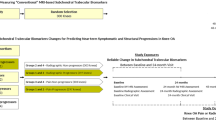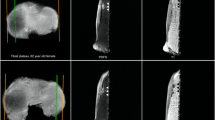Abstract
Summary
Subchondral trabecular bone structure was analyzed in knee osteoarthritis (OA) patients using 3-T MRI to investigate structural features of subchondral trabecular bone of knee OA. With OA progression, osteoporotic changes were observed in the lateral joint, showing a higher correlation than sclerotic changes in the medial joint.
Introduction
To investigate structural features of subchondral trabecular bone of knee osteoarthritis (OA).
Methods
Sixty knees with KL grade 0–4 (all female) were examined. Fast imaging employing steady-state acquisition-cycled phases (FIESTA-c) and FatSat Spoiled gradient recalled acquisition in the steady state (SPGR) images were acquired by 3-T MRI. At four sites (the medial femur, medial tibia, lateral femur, and lateral tibia), subchondral trabecular bone structure was analyzed by FIESTA-c imaging, cartilage area was measured by SPGR imaging, and their correlation was analyzed. In addition, the subjects were classified into four groups from the cartilage area measured by SPGR imaging, and subchondral trabecular bone structure in each group was compared.
Results
As cartilage area decreased in the medial joint, bone volume fraction and trabecular thickness in the medial tibia increased, and bone volume fraction, trabecular thickness, number, and connectivity in the lateral femur and lateral tibia decreased (r ≥ 0.4 or ≤−0.4, p ≤ 0.001). Compared to medially, the changes laterally showed a higher correlation. When the medial-lateral ratio of trabecular thickness in the tibia was determined, it had the highest correlation coefficient (r=−0.7, p < 0.001). These changes were not significantly detected in the early stage.
Conclusions
To more sensitively detect OA changes in subchondral trabecular bone structure, a focus on osteoporotic changes in the lateral joint and the medial-lateral ratio would be useful. Detectability of early OA remains unknown, but based on a strong correlation with the degree of OA progression, trabecular structural analysis of subchondral bone may be a useful parameter to evaluate OA severity and evaluate treatment.





Similar content being viewed by others
References
Radin EL, Rose RM (1986) Role of subchondral bone in the initiation and progression of cartilage damage. Clin Orthop Relat Res 213:34–40
Lajeunesse D (2004) The role of bone in the treatment of osteoarthritis. Osteoarthritis Cartilage 12:S34–S38
Kwan Tat S, Lajeunesse D, Pelletier JP, Martel-Pelletier J (2010) Targeting subchondral bone for treating osteoarthritis: what is the evidence? Best Pract Res Clin Rheumatol 24:51–70
Hayami T, Pickarski M, Wesolowski GA, McLane J, Bone A, Destefano J et al (2004) The role of subchondral bone remodeling in osteoarthritis: reduction of cartilage degeneration and prevention of osteophyte formation by alendronate in the rat anterior cruciate ligament transection model. Arthritis Rheum 50:1193–1206
Hayami T, Pickarski M, Zhuo Y, Wesolowski GA, Rodan GA, le Duong T (2006) Characterization of articular cartilage and subchondral bone changes in the rat anterior cruciate ligament transection and meniscectomized models of osteoarthritis. Bone 38:234–243
Felson DT, Niu J, Guermazi A, Roemer F, Aliabadi P, Clancy M et al (2007) Correlation of the development of knee pain with enlarging bone marrow lesions on magnetic resonance imaging. Arthritis Rheum 56:2986–2992
Lo GH, McAlindon TE, Niu J, Zhang Y, Beals C, Dabrowski C et al (2009) Bone marrow lesions and joint effusion are strongly and independently associated with weight-bearing pain in knee osteoarthritis: data from the osteoarthritis initiative. Osteoarthritis Cartilage 17:1562–1569
Pelletier JP, Martel-Pelletier J (2007) DMOAD developments: present and future. Bull NYU Hosp Jt Dis 65:242–248
Qvist P, Bay-Jensen AC, Christiansen C, Dam EB, Pastoureau P, Karsdal MA (2008) The disease modifying osteoarthritis drug (DMOAD): is it in the horizon? Pharmacol Res 58:1–7
Carbone LD, Nevitt MC, Wildy K, Barrow KD, Harris F, Felson D et al (2004) The relationship of antiresorptive drug use to structural findings and symptoms of knee osteoarthritis. Arthritis Rheum 50:3516–3525
Garnero P, Aronstein WS, Cohen SB, Conaghan PG, Cline GA, Christiansen C et al (2008) Relationships between biochemical markers of bone and cartilage degradation with radiological progression in patients with knee osteoarthritis receiving risedronate: the knee osteoarthritis structural arthritis randomized clinical trial. Osteoarthritis Cartilage 16:660–666
Manicourt DH, Altman RD, Williams JM, Devogelaer JP, Druetz-Van Egeren A, Lenz ME et al (1999) Treatment with calcitonin suppresses the responses of bone, cartilage, and synovium in the early stages of canine experimental osteoarthritis and significantly reduces the severity of the cartilage lesions. Arthritis Rheum 42:1159–1167
Karsdal MA, Byrjalsen I, Henriksen K, Riis BJ, Lau EM, Arnold M et al (2010) The effect of oral salmon calcitonin delivered with 5-CNAC on bone and cartilage degradation in osteoarthritic patients: a 14-day randomized study. Osteoarthritis Cartilage 18:150–159
Ito M, Ikeda K, Nishiguchi M, Shindo H, Uetani M, Hosoi T et al (2005) Multi-detector row CT imaging of vertebral microstructure for evaluation of fracture risk. J Bone Miner Res 20:1828–1836
Majumdar S, Genant HK, Grampp S, Newitt DC, Truong VH, Lin JC et al (1997) Correlation of trabecular bone structure with age, bone mineral density, and osteoporotic status: in vivo studies in the distal radius using high resolution magnetic resonance imaging. J Bone Miner Res 12:111–118
Link TM, Majumdar S, Augat P, Lin JC, Newitt D, Lu Y et al (1998) In vivo high resolution MRI of the calcaneus: differences in trabecular structure in osteoporosis patients. J Bone Miner Res 13:1175–1182
Beuf O, Ghosh S, Newitt DC, Link TM, Steinbach L, Ries M et al (2002) Magnetic resonance imaging of normal and osteoarthritic trabecular bone structure in the human knee. Arthritis Rheum 46:385–393
Gomberg BR, Wehrli FW, Vasili B, Weening RH, Saha PK, Song HK et al (2004) Reproducibility and error sources of micro-MRI-based trabecular bone structural parameters of the distal radius and tibia. Bone 35:266–276
Krug R, Banerjee S, Han ET, Newitt DC, Link TM, Majumdar S (2005) Feasibility of in vivo structural analysis of high-resolution magnetic resonance images of the proximal femur. Osteoporos Int 16:1307–1314
Iita N, Handa S, Tomiha S, Kose K (2007) Development of a compact MRI system for measuring the trabecular bone microstructure of the finger. Magn Reson Med 57:272–277
Bolbos RI, Zuo J, Banerjee S, Link TM, Ma CB, Li X et al (2008) Relationship between trabecular bone structure and articular cartilage morphology and relaxation times in early OA of the knee joint using parallel MRI at 3T. Osteoarthritis Cartilage 16:1150–1159
Hahn M, Vogel M, Pompesius-Kempa M, Delling G (1992) Trabecular bone pattern factor—a new parameter for simple quantification of bone microarchitecture. Bone 13:327–330
Harrigan TP, Mann RW (1984) Characterization of microstructural anisotropy in orthotropic materials using a second rank tensor. J Mater Sci 19:761–767
Ogata K, Yoshii I, Kawamura H, Miura H, Arizono T, Sugioka Y (1991) Standing radiographs cannot determine the correction in high tibial osteotomy. J Bone Joint Surg Br 73:927–931
Chappard C, Peyrin F, Bonnassie A, Lemineur G, Brunet-Imbault B, Lespessailles E et al (2006) Subchondral bone micro-architectural alterations in osteoarthritis: a synchrotron micro-computed tomography study. Osteoarthritis Cartilage 14:215–223
Ding M, Odgaard A, Hvid I (2003) Changes in the three-dimensional microstructure of human tibial cancellous bone in early osteoarthritis. J Bone Joint Surg Br 85:906–912
Bobinac D, Spanjol J, Zoricic S, Maric I (2003) Changes in articular cartilage and subchondral bone histomorphometry in osteoarthritic knee joints in humans. Bone 32:284–290
Lindsey CT, Narasimhan A, Adolfo JM, Jin H, Steinbach LS, Link T et al (2004) Magnetic resonance evaluation of the interrelationship between articular cartilage and trabecular bone of the osteoarthritic knee. Osteoarthritis Cartilage 12:86–96
Sell CA, Masi JN, Burghardt A, Newitt D, Link TM, Majumdar S (2005) Quantification of trabecular bone structure using magnetic resonance imaging at 3 Tesla-calibration studies using microcomputed tomography as a standard of reference. Calcif Tissue Int 76:355–364
Acknowledgments
The authors would like to thank Katsuhiko Aikawa and Tomoko Nakata (Division of Radiology, Nagasaki University Hospital, Nagasaki, Japan) for MRI imaging. This research was supported by a Grant-in-Aid for Scientific Research for Young Researchers (B) by the Japan Society for the Promotion of Science (JSPS).
Conflicts of interest
None.
Author information
Authors and Affiliations
Corresponding author
Rights and permissions
About this article
Cite this article
Chiba, K., Uetani, M., Kido, Y. et al. Osteoporotic changes of subchondral trabecular bone in osteoarthritis of the knee: a 3-T MRI study. Osteoporos Int 23, 589–597 (2012). https://doi.org/10.1007/s00198-011-1585-2
Received:
Accepted:
Published:
Issue Date:
DOI: https://doi.org/10.1007/s00198-011-1585-2




